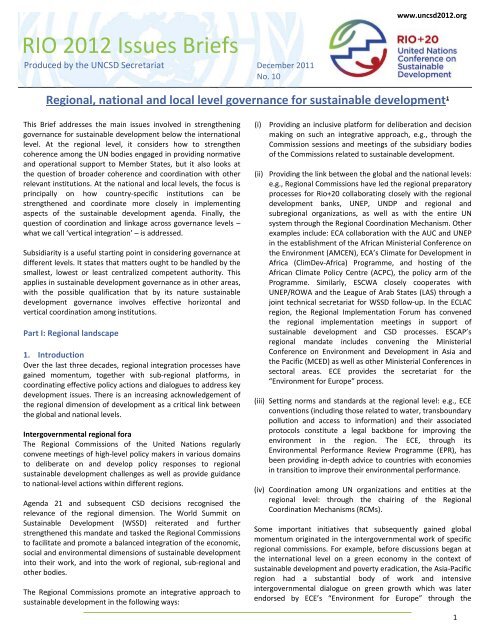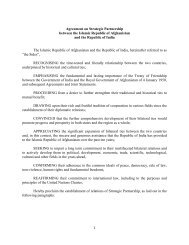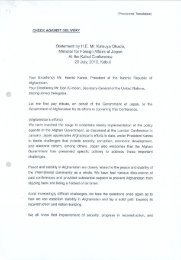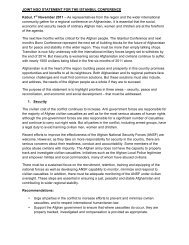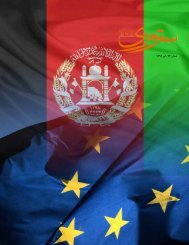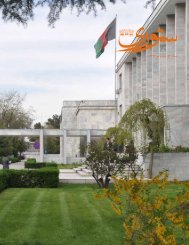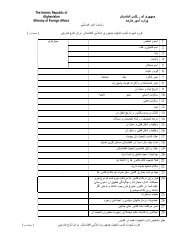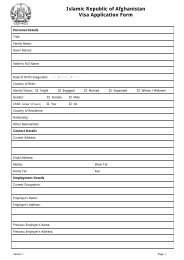Regional, national and local level - Rio+20
Regional, national and local level - Rio+20
Regional, national and local level - Rio+20
You also want an ePaper? Increase the reach of your titles
YUMPU automatically turns print PDFs into web optimized ePapers that Google loves.
RIO 2012 Issues BriefsProduced by the UNCSD Secretariat December 2011No. 10www.uncsd2012.org<strong>Regional</strong>, <strong>national</strong> <strong>and</strong> <strong>local</strong> <strong>level</strong> governance for sustainable development 1This Brief addresses the main issues involved in strengtheninggovernance for sustainable development below the inter<strong>national</strong><strong>level</strong>. At the regional <strong>level</strong>, it considers how to strengthencoherence among the UN bodies engaged in providing normative<strong>and</strong> operational support to Member States, but it also looks atthe question of broader coherence <strong>and</strong> coordination with otherrelevant institutions. At the <strong>national</strong> <strong>and</strong> <strong>local</strong> <strong>level</strong>s, the focus isprincipally on how country‐specific institutions can bestrengthened <strong>and</strong> coordinate more closely in implementingaspects of the sustainable development agenda. Finally, thequestion of coordination <strong>and</strong> linkage across governance <strong>level</strong>s –what we call ‘vertical integration’ – is addressed.Subsidiarity is a useful starting point in considering governance atdifferent <strong>level</strong>s. It states that matters ought to be h<strong>and</strong>led by thesmallest, lowest or least centralized competent authority. Thisapplies in sustainable development governance as in other areas,with the possible qualification that by its nature sustainabledevelopment governance involves effective horizontal <strong>and</strong>vertical coordination among institutions.Part I: <strong>Regional</strong> l<strong>and</strong>scape1. IntroductionOver the last three decades, regional integration processes havegained momentum, together with sub‐regional platforms, incoordinating effective policy actions <strong>and</strong> dialogues to address keydevelopment issues. There is an increasing acknowledgement ofthe regional dimension of development as a critical link betweenthe global <strong>and</strong> <strong>national</strong> <strong>level</strong>s.Intergovernmental regional foraThe <strong>Regional</strong> Commissions of the United Nations regularlyconvene meetings of high‐<strong>level</strong> policy makers in various domainsto deliberate on <strong>and</strong> develop policy responses to regionalsustainable development challenges as well as provide guidanceto <strong>national</strong>‐<strong>level</strong> actions within different regions.Agenda 21 <strong>and</strong> subsequent CSD decisions recognised therelevance of the regional dimension. The World Summit onSustainable Development (WSSD) reiterated <strong>and</strong> furtherstrengthened this m<strong>and</strong>ate <strong>and</strong> tasked the <strong>Regional</strong> Commissionsto facilitate <strong>and</strong> promote a balanced integration of the economic,social <strong>and</strong> environmental dimensions of sustainable developmentinto their work, <strong>and</strong> into the work of regional, sub‐regional <strong>and</strong>other bodies.The <strong>Regional</strong> Commissions promote an integrative approach tosustainable development in the following ways:(i) Providing an inclusive platform for deliberation <strong>and</strong> decisionmaking on such an integrative approach, e.g., through theCommission sessions <strong>and</strong> meetings of the subsidiary bodiesof the Commissions related to sustainable development.(ii) Providing the link between the global <strong>and</strong> the <strong>national</strong> <strong>level</strong>s:e.g., <strong>Regional</strong> Commissions have led the regional preparatoryprocesses for <strong>Rio+20</strong> collaborating closely with the regionaldevelopment banks, UNEP, UNDP <strong>and</strong> regional <strong>and</strong>subregional organizations, as well as with the entire UNsystem through the <strong>Regional</strong> Coordination Mechanism. Otherexamples include: ECA collaboration with the AUC <strong>and</strong> UNEPin the establishment of the African Ministerial Conference onthe Environment (AMCEN), ECA’s Climate for Development inAfrica (ClimDev‐Africa) Programme, <strong>and</strong> hosting of theAfrican Climate Policy Centre (ACPC), the policy arm of theProgramme. Similarly, ESCWA closely cooperates withUNEP/ROWA <strong>and</strong> the League of Arab States (LAS) through ajoint technical secretariat for WSSD follow‐up. In the ECLACregion, the <strong>Regional</strong> Implementation Forum has convenedthe regional implementation meetings in support ofsustainable development <strong>and</strong> CSD processes. ESCAP’sregional m<strong>and</strong>ate includes convening the MinisterialConference on Environment <strong>and</strong> Development in Asia <strong>and</strong>the Pacific (MCED) as well as other Ministerial Conferences insectoral areas. ECE provides the secretariat for the“Environment for Europe” process.(iii) Setting norms <strong>and</strong> st<strong>and</strong>ards at the regional <strong>level</strong>: e.g., ECEconventions (including those related to water, transboundarypollution <strong>and</strong> access to information) <strong>and</strong> their associatedprotocols constitute a legal backbone for improving theenvironment in the region. The ECE, through itsEnvironmental Performance Review Programme (EPR), hasbeen providing in‐depth advice to countries with economiesin transition to improve their environmental performance.(iv) Coordination among UN organizations <strong>and</strong> entities at theregional <strong>level</strong>: through the chairing of the <strong>Regional</strong>Coordination Mechanisms (RCMs).Some important initiatives that subsequently gained globalmomentum originated in the intergovernmental work of specificregional commissions. For example, before discussions began atthe inter<strong>national</strong> <strong>level</strong> on a green economy in the context ofsustainable development <strong>and</strong> poverty eradication, the Asia‐Pacificregion had a substantial body of work <strong>and</strong> intensiveintergovernmental dialogue on green growth which was laterendorsed by ECE’s “Environment for Europe” through the1
adoption in 2010 of the “Astana Initiative” as a framework forgreen economy principles in Europe <strong>and</strong> Asia <strong>and</strong> the Pacific.<strong>Regional</strong> Coordination Mechanisms (RCMs)M<strong>and</strong>ated by ECOSOC 2 , the <strong>Regional</strong> Commissions 3 hold regularinter‐agency meetings in each region to improve policy coherence<strong>and</strong> programme coordination among the organizations of the UNsystem <strong>and</strong> non‐UN partners in that region. These meetings areconducted through the <strong>Regional</strong> Coordination Mechanism (RCM),which is chaired by the Deputy Secretary General <strong>and</strong>coordinated by the <strong>Regional</strong> Commissions. RCM meetings focuson policy <strong>and</strong> programming issues of a regional nature <strong>and</strong> areguided by regional priorities. The RCMs in different regions haveon average a membership of 30 UN <strong>and</strong> affiliated entities,including the <strong>Regional</strong> Development Banks.The RCMs have become the vehicle for delivery of joint analyticalproducts in support of regional development frameworks.<strong>Regional</strong> UNDG TeamsThe UN Country Team (UNCT) 4 is guided <strong>and</strong> supported by the<strong>Regional</strong> UN Development Group (UNDG) Teams 5 (formerlyknown as “<strong>Regional</strong> Directors Teams”). The <strong>Regional</strong> UNDGTeams’ core functions are focused on the provision of coherent<strong>and</strong> timely technical support to UNCTs, quality assurance of UNDevelopment Assistance Frameworks (UNDAFs) 6 , performancemanagement through the Resident Coordinator (RC)/UNCTPerformance Appraisal system, <strong>and</strong> “trouble shooting” inchallenging country situations.<strong>Regional</strong> Development Banks<strong>Regional</strong> development banks 7 have emerged as important actorsfor economic integration <strong>and</strong> development at the <strong>national</strong> as wellas the sub‐regional <strong>level</strong> (e.g., ADB in the Greater MekongSubregion). They provide effective instruments to funddevelopment initiatives. Sustainability <strong>and</strong> the environment arepost‐Rio 1992 additions to the focal areas of these banks (forexample, EBRD D8 ).<strong>Regional</strong>/sub‐regional intergovernmental organizations<strong>Regional</strong>/subregional organizations, such as the European Union,African Union, MERCOSUR, ASEAN, CARICOM <strong>and</strong> the PacificIsl<strong>and</strong>s Forum, to name a few, provide platforms for effectivepolicy dialogue <strong>and</strong> actions to address key development issues atthe regional <strong>and</strong> sub‐regional <strong>level</strong>s. These organizations areimportant players in determining the development agenda.Some have more comprehensive cooperation programmes thanothers for which trade cooperation <strong>and</strong> integration remains thetop priority.<strong>Regional</strong>/sub‐regional partnerships, targeted cooperationmechanisms<strong>Regional</strong> partnerships are also playing an increasingly importantrole. For example, the East Asia Climate Partnership (EACP) is acooperative mechanism that aims to tackle climate change <strong>and</strong>promote green growth in the Asian region. In the Caribbean, the<strong>Regional</strong> Coordinating Mechanism (RCM) is a coordinationmechanism, promoting partnership among ECLAC, UNEP, theCaribbean Community (CARICOM) Secretariat, the Association ofCaribbean States (ACS), <strong>and</strong> the Organisation of EasternCaribbean States (OECS) Secretariat. In the Pacific, the Council of<strong>Regional</strong> Organizations of the Pacific (CROP) SustainableDevelopment Working Group coordinates the activities of itsmembers, which include both UN <strong>and</strong> non‐UN sub‐regionalorganizations.How these organizations currently work togetherIn 2008, it was agreed within the UN system 9 that: <strong>Regional</strong>Commissions lead on regional policy issues, together with thelinkages to global policy issues, with UNDG members supportingas required; <strong>Regional</strong> UNDG Teams manage country operationalwork (country programming <strong>and</strong> policy work), with the <strong>Regional</strong>Commissions participating as needed.2. Enhancing coordination <strong>and</strong> integration ofregional governanceIt is important that regional governance institutions coordinateamong themselves <strong>and</strong> integrate effectively the social, economic<strong>and</strong> environmental dimensions of sustainable development.<strong>Regional</strong> institutions need to address region‐specific issues;manage regional spillovers, externalities, interdependencies;support <strong>national</strong> policy development <strong>and</strong> implementation withinthe region; provide region specific inputs to inform global policymaking.How well is it working at present?The functions <strong>and</strong> complementarities of the RCMs vis‐a vis theregional UNDG teams are clearly outlined, with areas of synergyidentified 10 . For example, the outcome of the policy coherencework of the RCMs, including regional <strong>and</strong> sub‐regionalframeworks, can be conveyed to regional UNDG teams to informtheir country‐<strong>level</strong> actions; whereas the country‐<strong>level</strong> experiencecan inform the regional discussions on policies. A good start hasbeen made by scheduling the meetings of the two mechanismsback‐to‐back in all regions to ensure complementarities <strong>and</strong> toallow outcomes of one to feed into the other. However, slowprogress has been recorded in the regions regarding improvingcomplementarities <strong>and</strong> synergies between the two coordinationmechanisms.3. The way forwardIdeas on how regional governance could be better integratedacross the three pillarsIssues relating to sustainable development governance at theregional <strong>level</strong> <strong>and</strong> the role of emerging new stakeholders <strong>and</strong>actors, such as the private sector, civil society, trade unions <strong>and</strong>2
farmers, could be further studied. Current inter‐linkages <strong>and</strong> gapsbetween key organizations (i.e. UN, <strong>Regional</strong> Development Banks,sub‐regional organizations) could be further analyzed to helpaddress the lack of coherence or multiplicity of integrationprocesses <strong>and</strong> initiatives. Such insights would be useful indesigning improved <strong>and</strong> more effective implementationprogrammes in the near future.Ideas on how UN agencies can work better together at theregional <strong>level</strong>UN organizations working at the regional <strong>level</strong> should develop 11an agreed medium‐term capacity‐building framework.Stocktaking <strong>and</strong> reviews should feed into a coherent <strong>and</strong>coordinated regional framework, informed by normative policiesformulated at the inter<strong>national</strong> <strong>level</strong>. To this end, the roles of the<strong>Regional</strong> Commissions <strong>and</strong> the UNDG <strong>Regional</strong> Teams areabsolutely critical. Greater coherence <strong>and</strong> cohesiveness 12between RCMs <strong>and</strong> <strong>Regional</strong> UNDG Teams should be forged. TheRCMs <strong>and</strong> the <strong>Regional</strong> UNDG teams could be linked morestrongly to ensure input from the normative regional work intothe work of the <strong>Regional</strong> UNDG teams in support of UNCTs <strong>and</strong>vice versa. Engagement <strong>and</strong> commitment at the highest <strong>level</strong> tocloser collaboration would go a long way in ensuring policycoherence <strong>and</strong> improving coordination among the workprogrammes of UN organizations at the regional <strong>level</strong>. The<strong>Regional</strong> Commissions <strong>and</strong> UNDG, as the UN entities m<strong>and</strong>atedwith coordination responsibilities at regional <strong>level</strong>, shouldprepare a common regional roadmap on how the actions of allregional actors could be better integrated across the three pillars.The strategy should be discussed <strong>and</strong> agreed upon by all actors atthe RCMs <strong>and</strong> <strong>Regional</strong> UNDGs, operating as One UN at theregional <strong>level</strong>. Under the leadership of the Chief Executives Board(CEB), the linkages of the High‐Level Committee on Programmes(HLCP) with the RCMs (as a means of enhancing policycoordination between global <strong>and</strong> regional <strong>level</strong>s) <strong>and</strong> with UNDG(as a means of enhancing implementation at the <strong>national</strong> <strong>level</strong>)continue to be of relevance.Part II: Governance at <strong>national</strong> <strong>and</strong> <strong>local</strong> <strong>level</strong>s1. IntroductionGovernance at <strong>national</strong> <strong>and</strong> <strong>local</strong> <strong>level</strong>s can be described as theprocesses by which public policy decisions are made <strong>and</strong>implemented. It is the result of interactions, relationships <strong>and</strong>networks among the different sectors (government, public sector,private sector <strong>and</strong> civil society) <strong>and</strong> involves decisions,negotiation, <strong>and</strong> different power relations between stakeholdersto determine who gets what, when <strong>and</strong> how – that is, who isresponsible <strong>and</strong> accountable for what actions.Some elements of sustainable development governance include:- integration of economic, social <strong>and</strong> environmentaldimensions across sectors <strong>and</strong> policy domains(horizontal integration);- coherence in policy design across domains withsometimes competing priorities (coherence);- inter‐connectedness between governance <strong>level</strong>s (verticalintegration <strong>and</strong> coherence);- effectiveness <strong>and</strong> efficiency of administration <strong>and</strong> publicservice delivery;- quality <strong>and</strong> inclusiveness of public policy <strong>and</strong> decisionmakingprocedures;- engagement of all constituencies of civil society throughdifferent forms of participation;- transparency <strong>and</strong> accountability.It is evident that governance for sustainable developmentinvolves a wide range of entities, networks <strong>and</strong> bodies within <strong>and</strong>outside government that play a role in policy‐making <strong>and</strong>implementation of sustainable development priorities. While thiscan provide flexibility <strong>and</strong> innovative solutions to challenges ofcoordination <strong>and</strong> coherence, it can in turn influence effectivenessof oversight, accountability <strong>and</strong> ultimately implementation.In the Johannesburg Plan of Implementation (para. 162a), Statescommitted to “[c]ontinue to promote coherent <strong>and</strong> coordinatedapproaches to institutional frameworks for sustainabledevelopment at all <strong>national</strong> <strong>level</strong>s, including through, asappropriate, the establishment or strengthening of existingauthorities <strong>and</strong> mechanisms for policy making, coordination <strong>and</strong>implementation <strong>and</strong> enforcement of laws.” Furthermore, theycommitted to take immediate steps to make progress in theformulation <strong>and</strong> elaboration of <strong>national</strong> strategies for sustainabledevelopment <strong>and</strong> begin their implementation by 2005 (para.162b). It is widely recognized that such strategies can takedifferent forms such as poverty reduction strategies, <strong>national</strong>development plans or similar, as long as they fulfil therequirement of integrating economic, social <strong>and</strong> environmentalconcerns in a balanced <strong>and</strong> integrated manner. As of 2009, 106countries had reported their National Sustainable DevelopmentStrategies (NSDS) to the Commission on SustainableDevelopment.Local authorities, one of the nine major group sectors recognizedby Agenda 21 13 are considered the <strong>level</strong> of governance closest tothe people, playing a vital role in mobilizing <strong>and</strong> responding to thepublic to promote sustainable development. Local governmentinstitutions come in many shapes <strong>and</strong> sizes, functioning as part ofwidely varying constitutional <strong>and</strong> administrative frameworks, yetsharing some common features <strong>and</strong> responsibilities. As stated inAgenda 21: “Local authorities construct, operate <strong>and</strong> maintaineconomic, social <strong>and</strong> environmental infrastructure, overseeplanning processes, establish <strong>local</strong> environmental policies <strong>and</strong>regulations, <strong>and</strong> assist in implementing <strong>national</strong> <strong>and</strong> sub<strong>national</strong>environmental policies.” Thus even when frameworks, norms <strong>and</strong>3
st<strong>and</strong>ards are set at a higher <strong>level</strong> of authority, <strong>local</strong> governmentspossess competencies for numerous sectors such as urbanplanning, urban management, transportation, water, wastemanagement, air quality management, public health, promotionof social services <strong>and</strong> education.There is no single model of governance of sustainabledevelopment. As a rule, however, <strong>local</strong> governments are subjectto <strong>national</strong> or regional legislation, dependent to varying degreeson higher <strong>level</strong>s of government for funding, <strong>and</strong> have limitedlegislative powers.2. An issue of integration <strong>and</strong> coherenceThere are many examples of good practices, as well as guidelines,resource materials, planning models, <strong>and</strong> tools that both <strong>national</strong><strong>and</strong> <strong>local</strong> governments can use to implement sustainabledevelopment action plans or strategies. In this regard, it is wellrecognized that institutional arrangements for sustainabledevelopment are key to achieving integrated decision‐making <strong>and</strong>implementation of sustainable development priorities.Experience has shown that a number of factors which areapplicable to most countries contribute to success:1. A high‐<strong>level</strong> government commitment to sustainabledevelopment articulated through a common vision orstrategic objective which also informs governance at the <strong>local</strong><strong>level</strong>. Such commitment can follow on commitments made atthe inter<strong>national</strong> <strong>level</strong> which are then translated into goals<strong>and</strong> priorities taking into account the specific <strong>national</strong>context <strong>and</strong> anchored in <strong>national</strong> legislation.2. Strong horizontal coordination <strong>and</strong> coherence mechanismsled by a high‐<strong>level</strong> government office with substantiveauthority. Such mechanisms can take a variety of forms, suchas presidential commissions, inter‐ministerial working groupsor task forces where participating entities share a commonresponsibility for ensuring integration <strong>and</strong> coherence whilemaintaining operational m<strong>and</strong>ates.3. Balanced horizontal integration of policy concerns whichadequately considers synergies <strong>and</strong> trade‐offs associatedwith proposed policy measures across economic, social <strong>and</strong>environmental domains.4. An integrated development planning process <strong>and</strong> documentunderpinned by integrated assessment methods <strong>and</strong>appropriate measures of progress (such as indicators ofsustainable development), which ties directly to Medium‐Term Expenditure Frameworks, to ensure that integratedstrategies <strong>and</strong> policies are funded.5. Strong vertical integration which ensures alignment between<strong>national</strong>, regional, <strong>and</strong> <strong>local</strong> <strong>level</strong>s of government. Properalignment can reinforce <strong>and</strong> support achieving goals acrossterritories <strong>and</strong> facilitate implementation at all <strong>level</strong>s, ifadequate resources are attached, taking into account that<strong>local</strong> government is often at the frontline of theimplementation challenge.6. Institutionalized processes for ensuring meaningfulparticipation of all civil society actors, including the privatesector <strong>and</strong> <strong>local</strong> government. This has been shown not onlyto facilitate public awareness regarding sustainabledevelopment issues, but to condition the quality,accountability <strong>and</strong> impact of sustainable development plans.The experience of <strong>national</strong> councils <strong>and</strong> stakeholder advisorybodies has shown their potential as a forum for openness<strong>and</strong> transparency, articulating priorities <strong>and</strong> concerns, <strong>and</strong>monitoring progress made in achieving sustainabledevelopment goals.7. In this regard, access to data <strong>and</strong> information is not onlycritical to goal setting <strong>and</strong> as a communication <strong>and</strong> outreachtool for engaging stakeholders, but experience has shownthat increased access to high quality up‐to‐date informationcan serve as an integration tool in <strong>and</strong> of itself. In manycases, access to information on government budget <strong>and</strong>expenditures provides a critical tool for accountability <strong>and</strong>transparency.8. The <strong>national</strong> sustainable development strategy processimplies a continuous iterative process encompassingarticulation of priorities, monitoring, evaluation <strong>and</strong> reviewto ensure progress in implementation <strong>and</strong> accountabilitywhile allowing for adjustments in priority setting <strong>and</strong>implementation actions responding to new <strong>and</strong> emergingchallenges.9. Lastly, some countries have found it useful to undertakevoluntary sharing of experiences or reviews vis‐à‐vis othercountries engaged in similar strategy processes. This createsan opportunity to reflect on good governance experience <strong>and</strong>identify gaps <strong>and</strong> potential remedies in a collegial setting.3. Particular challenges at the <strong>local</strong> <strong>level</strong>Decentralization <strong>and</strong> devolution of functions <strong>and</strong> responsibilitiesto <strong>local</strong> governments has sometimes occurred without theaccompanying resources <strong>and</strong> legislative powers. Local authorities,with sub‐regional <strong>and</strong> <strong>national</strong> spheres of government “above”them, are especially prone to unfunded m<strong>and</strong>ates. Anotherdimension is that reforms granting <strong>local</strong> governments newpowers <strong>and</strong> responsibilities should go h<strong>and</strong>‐in‐h<strong>and</strong> with newpublic accountability mechanisms. There is also room to explorenew forms of social accountability mechanisms, such as citizenoversight bodies <strong>and</strong> participatory budgeting, which enable directengagement of citizens with government <strong>and</strong> complement moretraditional public accountability mechanisms.4. UN system support at country <strong>level</strong>While implementation of sustainable development priorities isthe sole responsibility of governments, a number of inter<strong>national</strong>actors are engaged at the <strong>national</strong> <strong>and</strong> <strong>local</strong> <strong>level</strong>s to providesupport in one or several areas of concern.4
Resident UN agencies, non‐resident UN agencies (NRAs) <strong>and</strong>inter<strong>national</strong> financial institutions (IFIs) all form part of UnitedNations Country Teams (UNCTs) to varying degrees. UN‐HABITAThas been supporting <strong>local</strong> governments around the world inenhancing <strong>local</strong> leadership for sustainable development.Experience reported by country teams suggests that, in order toachieve the necessary <strong>level</strong> of capacity to support <strong>national</strong>institutional arrangements for sustainable development, a furthersystematized inclusion of the expertise of NRAs <strong>and</strong> IFIs at thecountry <strong>level</strong> would be an advantage. Typical areas of suchsupport include the development of <strong>national</strong> strategies,regulations, frameworks <strong>and</strong> policies, but also capacity building ofall stakeholders at all <strong>level</strong>s. Well functioning UNCTs have thepotential to provide support by providing policy guidance;developing indicators <strong>and</strong> other measurements; building capacityof government to deliver on commitments; improvinginformation sharing <strong>and</strong> knowledge networking; finally, linkingissues/frameworks for greater cross‐sectoral cooperation.5. The way forwardThough many implementation measures have been taken bygovernments <strong>and</strong> non‐government stakeholders alike, barriers toimplementation such as fragmented decision‐making, conflictingpolicy targets <strong>and</strong> insufficient or ineffective coordination persist.The lessons learnt from the past 20 years should provide a basisfor the further improvement of governance at the <strong>national</strong> <strong>and</strong><strong>local</strong> <strong>level</strong>s. This includes seeking a renewed attention to <strong>national</strong><strong>and</strong> sub‐<strong>national</strong> sustainable development strategies as a keyvehicle for integration <strong>and</strong> coherence in sustainable developmentpolicy design <strong>and</strong> implementation, if appropriately linked withresource mobilization.There is a need to pursue cooperation <strong>and</strong> integration along twoaxes – vertical <strong>and</strong> horizontal. All governance <strong>level</strong>s from <strong>local</strong>through global need to be vertically interconnected, knittingtogether sometimes fragmented <strong>and</strong> overlapping governancearrangements. This is sometimes referred to as the notion ofmulti‐<strong>level</strong> governance. The strategies <strong>and</strong> SD policies at the <strong>local</strong><strong>level</strong> should be integrated into sub‐<strong>national</strong> <strong>and</strong> <strong>national</strong> plans<strong>and</strong> processes for SD.In the context of many “emerging issues” such as climate change<strong>and</strong> rapid urbanization in many parts of the world, <strong>local</strong>authorities’ frontline responsibility for provision of basic services<strong>and</strong> spatial planning places intense strains on their institutional<strong>and</strong> human capacities. The sustainable developmentimplementation gap can therefore only be closed if the capacitiesof <strong>local</strong> authorities are significantly strengthened.Future efforts should enhance capacity building for <strong>local</strong>authorities <strong>and</strong> ensure that resources follow implementingauthority. For <strong>local</strong> authorities to be successful in their work forsustainable development, it is crucial that favourable conditionsare put in place by <strong>national</strong> governments, since there is a limit towhat <strong>local</strong> authorities can achieve on their own. It is imperativethat decentralization policies are accompanied by all the neededpolitical, legal <strong>and</strong> financial support that <strong>local</strong> authorities need forimplementing their <strong>local</strong>ized strategies for sustainability.At the heart of the debate on institutional strengthening <strong>and</strong>capacity development are the use of data <strong>and</strong> information tobuild consensus <strong>and</strong> support decision making in an integratedmanner, the ability to provide leadership on cross‐sectoral issues,<strong>and</strong> the reinforcement of analytical <strong>and</strong> strategic planningcapacities for multi‐sectoral issues. The enabling environmentwithin which this can happen is a key dimension of capacitybuilding at the <strong>local</strong> <strong>level</strong>.Looking forward, UNDG <strong>and</strong> entities at headquarters could beencouraged to strengthen support for the further application ofgood practices at country <strong>level</strong> in furtherance of governance forsustainable development, including in the areas of developingsuitable coordination mechanisms that address sustainabledevelopment in its totality; integration <strong>and</strong> coherence in policydesign; support for meaningful stakeholder participation indecision‐making; outreach <strong>and</strong> communication. In addition,opportunities could be sought to facilitate learning <strong>and</strong> sharing ofexperiences among peers, including through use of technologicalinnovations.The purpose of the Rio 2012 Issues Briefs is to provide a channelfor policymakers <strong>and</strong> other interested stakeholders to discuss <strong>and</strong>review issues relevant to the objective <strong>and</strong> themes of theconference, including a green economy in the context ofsustainable development <strong>and</strong> poverty eradication, as well as theinstitutional framework for sustainable development.For further information on this Brief, contact Friedrich Soltau(soltau@un.org).1We would like to acknowledge inputs received from the <strong>Regional</strong> Commissions,UNESCO, GEF, UN‐HABITAT, UNEP <strong>and</strong> UNDP.2Resolution 1998/463CEB/2009/HLCP‐XVII/CRP.24The main purpose of the UN Country Team is for individual agencies to plan <strong>and</strong>work together to ensure inter‐agency coordination in delivering tangible results insupport of the development agenda of the Government. Source:http://www.undg.org/index.cfm?P=1257.5http://www.undg.org/index.cfm?P=6846The UN Development Assistance Framework (UNDAF) is a programme documentbetween a government <strong>and</strong> the UNCT, describing collective actions <strong>and</strong> strategiesof the UN to support <strong>national</strong> development. The UNDAF includes outcomes,activities <strong>and</strong> UN agency responsibilities that are agreed by government.7The African Development Bank, Asian Development Bank, European Bank forReconstruction <strong>and</strong> Development, <strong>and</strong> Inter‐American Development Bank Group.5
8 http://www.ebrd.com/downloads/research/sustain/sr10e.pdf9 “The <strong>Regional</strong> Dimension of Development <strong>and</strong> the United Nations System”, draftunedited version (4 Oct 2011).10“The <strong>Regional</strong> Dimension of Development <strong>and</strong> the United Nations System”,draft unedited version (4 Oct 2011).11Recommendation 4 of “The <strong>Regional</strong> Dimension of Development <strong>and</strong> the UnitedNations System”.12Recommendation 6 of “The <strong>Regional</strong> Dimension of Development <strong>and</strong> the UnitedNations System”.13Agenda 21, Section III, Chapter 28:http://www.un.org/esa/dsd/dsd_aofw_mg/mg_locaauth.shtml6


